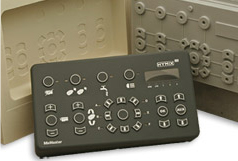
1. Does it fit? When integrating a keypad into the rest of the product, make sure that the dimensions are compatible and exact. When it’s time to assemble the product, you don’t want any gaps or overlaps to hinder usability.
2. Follow the best practices for layout design. There are some generally accepted guidelines that can help your designer to make the most of your product. Check out our SiTECH Application Guide for details.
3. Use contrasting colors for labeling keypad functions. It makes them easier to see, and therefore easier to operate. This is especially important for security or military rubber keypad design.
4. Do your labels mean what they say and say what they mean? Your user will have the best experience when labeling is clear, concise and meaningful. As a test, ask a few of your potential users to look at the product design. If they’re skeptical about what each button does, you’ll need to rethink the wording.
5. Does your layout have enough buttons? Functionality is a key part of a successful product. Make sure that the rubber keypad operates all of your product’s features, including speed, direction and volume. Consider a need for power activation or emergency stop controls.
6. Does your layout have too many buttons? Is the design simple enough that each button is easy to find and easy to use? If two functions are quite similar, this can cause confusion on the part of the user. Consider whether rearranging or eliminating buttons would be more user-friendly.
7. Do you need a rapid prototype? When you want to see what your product will look like under the present design specifications before the actual manufacturing process occurs, it’s helpful to see a prototype. Rapid prototyping is a replica that can be produced within a few weeks, in most cases. For more details on rapid prototyping, read our blog, “What Is a Rapid Prototype and How Can It Help You?’

Silicone rubber keypads can enhance the features and performance of your product. During the design phase, imagine how you would operate the device in real life, then add controls and labels to convey your ideas to the end user.








